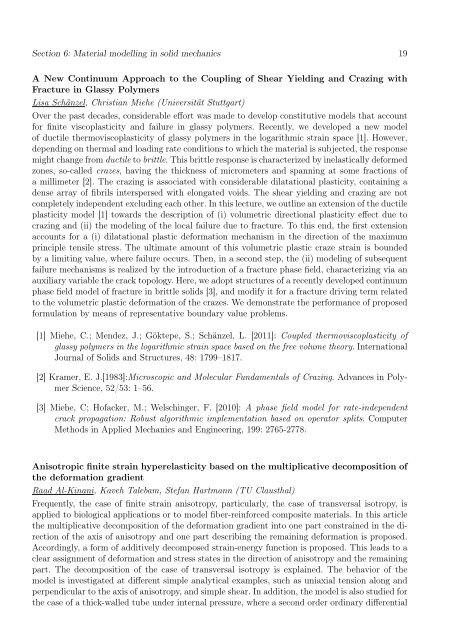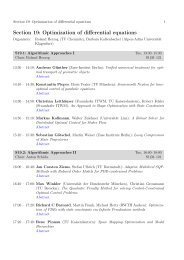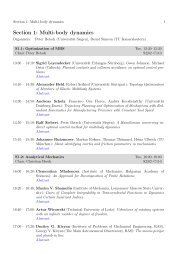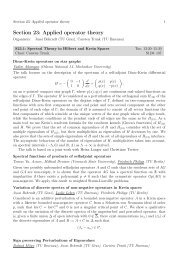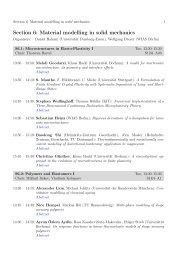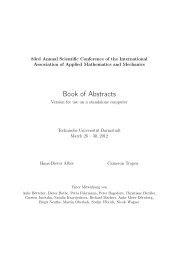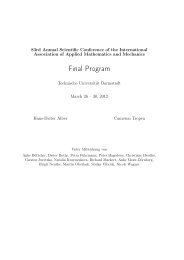Section 6: Material modelling in solid mechanics - GAMM 2012
Section 6: Material modelling in solid mechanics - GAMM 2012
Section 6: Material modelling in solid mechanics - GAMM 2012
Create successful ePaper yourself
Turn your PDF publications into a flip-book with our unique Google optimized e-Paper software.
<strong>Section</strong> 6: <strong>Material</strong> <strong>modell<strong>in</strong>g</strong> <strong>in</strong> <strong>solid</strong> <strong>mechanics</strong> 19<br />
A New Cont<strong>in</strong>uum Approach to the Coupl<strong>in</strong>g of Shear Yield<strong>in</strong>g and Craz<strong>in</strong>g with<br />
Fracture <strong>in</strong> Glassy Polymers<br />
Lisa Schänzel, Christian Miehe (Universität Stuttgart)<br />
Over the past decades, considerable effort was made to develop constitutive models that account<br />
for f<strong>in</strong>ite viscoplasticity and failure <strong>in</strong> glassy polymers. Recently, we developed a new model<br />
of ductile thermoviscoplasticity of glassy polymers <strong>in</strong> the logarithmic stra<strong>in</strong> space [1]. However,<br />
depend<strong>in</strong>g on thermal and load<strong>in</strong>g rate conditions to which the material is subjected, the response<br />
might change from ductile to brittle. This brittle response is characterized by <strong>in</strong>elastically deformed<br />
zones, so-called crazes, hav<strong>in</strong>g the thickness of micrometers and spann<strong>in</strong>g at some fractions of<br />
a millimeter [2]. The craz<strong>in</strong>g is associated with considerable dilatational plasticity, conta<strong>in</strong><strong>in</strong>g a<br />
dense array of fibrils <strong>in</strong>terspersed with elongated voids. The shear yield<strong>in</strong>g and craz<strong>in</strong>g are not<br />
completely <strong>in</strong>dependent exclud<strong>in</strong>g each other. In this lecture, we outl<strong>in</strong>e an extension of the ductile<br />
plasticity model [1] towards the description of (i) volumetric directional plasticity effect due to<br />
craz<strong>in</strong>g and (ii) the model<strong>in</strong>g of the local failure due to fracture. To this end, the first extension<br />
accounts for a (i) dilatational plastic deformation mechanism <strong>in</strong> the direction of the maximum<br />
pr<strong>in</strong>ciple tensile stress. The ultimate amount of this volumetric plastic craze stra<strong>in</strong> is bounded<br />
by a limit<strong>in</strong>g value, where failure occurs. Then, <strong>in</strong> a second step, the (ii) model<strong>in</strong>g of subsequent<br />
failure mechanisms is realized by the <strong>in</strong>troduction of a fracture phase field, characteriz<strong>in</strong>g via an<br />
auxiliary variable the crack topology. Here, we adopt structures of a recently developed cont<strong>in</strong>uum<br />
phase field model of fracture <strong>in</strong> brittle <strong>solid</strong>s [3], and modify it for a fracture driv<strong>in</strong>g term related<br />
to the volumetric plastic deformation of the crazes. We demonstrate the performance of proposed<br />
formulation by means of representative boundary value problems.<br />
[1] Miehe, C.; Mendez, J.; Göktepe, S.; Schänzel, L. [2011]: Coupled thermoviscoplasticity of<br />
glassy polymers <strong>in</strong> the logarithmic stra<strong>in</strong> space based on the free volume theory. International<br />
Journal of Solids and Structures, 48: 1799–1817.<br />
[2] Kramer, E. J.[1983]:Microscopic and Molecular Fundamentals of Craz<strong>in</strong>g. Advances <strong>in</strong> Polymer<br />
Science, 52/53: 1–56.<br />
[3] Miehe, C; Hofacker, M.; Welsch<strong>in</strong>ger, F. [2010]: A phase field model for rate-<strong>in</strong>dependent<br />
crack propagation: Robust algorithmic implementation based on operator splits. Computer<br />
Methods <strong>in</strong> Applied Mechanics and Eng<strong>in</strong>eer<strong>in</strong>g, 199: 2765-2778.<br />
Anisotropic f<strong>in</strong>ite stra<strong>in</strong> hyperelasticity based on the multiplicative decomposition of<br />
the deformation gradient<br />
Raad Al-K<strong>in</strong>ani, Kaveh Talebam, Stefan Hartmann (TU Clausthal)<br />
Frequently, the case of f<strong>in</strong>ite stra<strong>in</strong> anisotropy, particularly, the case of transversal isotropy, is<br />
applied to biological applications or to model fiber-re<strong>in</strong>forced composite materials. In this article<br />
the multiplicative decomposition of the deformation gradient <strong>in</strong>to one part constra<strong>in</strong>ed <strong>in</strong> the direction<br />
of the axis of anisotropy and one part describ<strong>in</strong>g the rema<strong>in</strong><strong>in</strong>g deformation is proposed.<br />
Accord<strong>in</strong>gly, a form of additively decomposed stra<strong>in</strong>-energy function is proposed. This leads to a<br />
clear assignment of deformation and stress states <strong>in</strong> the direction of anisotropy and the rema<strong>in</strong><strong>in</strong>g<br />
part. The decomposition of the case of transversal isotropy is expla<strong>in</strong>ed. The behavior of the<br />
model is <strong>in</strong>vestigated at different simple analytical examples, such as uniaxial tension along and<br />
perpendicular to the axis of anisotropy, and simple shear. In addition, the model is also studied for<br />
the case of a thick-walled tube under <strong>in</strong>ternal pressure, where a second order ord<strong>in</strong>ary differential


